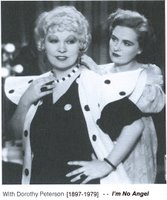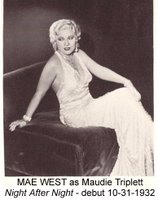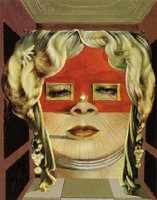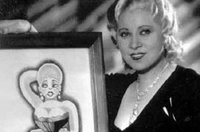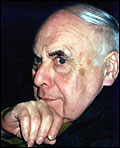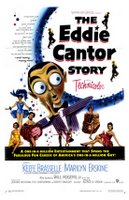Oh, to be kissed by Kesslere - - to be made love to by his
lens. In those bygone days of "fixed focus," an ambitious camera king like
George Maillard Kesslere could (and did) make his mark by snapping theatrical types as well as Park Avenue "royalty" and bluebloods.

• • Born in 1894, George Maillard Kesslere had set up a showy photo studio on East 50th Street by the early 1920s. During his long career, the lensman took pictures of
MAE WEST, Texas Guinan, Franklin D. Roosevelt and his wife Eleanor, Charlie Chaplin, Walter Damrosch, Arturo Toscanini, Rudy Vallee, Tallulah Bankhead, Alexander Woolcott, Beatrice Lillie, William H. Paley, Gertrude Lawrence, Charles Laughton, Helen Hayes, Jascha Heifetz, Admiral Richard E. Byrd, Marlon Brando, etc.
• • During Prohibition, his paintings were also attracting eyes and buyers. Kesslere's sassy canvasses for
Earl Carroll's Vanities were published in the very early 1930s.
• • In October 1927
MAE WEST was rehearsing her newest play
The Wicked Age, and preparing for out-of-town try-outs. [
The Wicked Age, which focuses on corrupt beauty pageants, was shown at Daly's 63rd Street Theatre November 4 - 23, 1927, a brief Broadway run.]

• • During October 1927 Mae West posed with legs exposed for George Maillard Kesslere. Her cheesecake promotional shots did not evoke the desired euphoria among critics that Mae had hoped for. Instead
Variety sneered, describing the entire enterprise as "a choice piece of
limburger" [
Variety 9 November 1927].
The New York Times was even harsher, labeling
The Wicked Age as "the low point of the theatrical season of 1927-28." Tsk! The slings and arrows of outrageous fortune only spurred Mae West forward. By 1928 she would be the toast of the town, ruling the Rialto as Diamond Lil.
• • In 1952, the lifelong bachelor (who had resided on East 62nd Street for many decades) donated the G. Maillard Kesslere Collection of 6,000 photographs and 500 paintings to the New York Public Library for its permanent theatre collection. That's a well-kept secret. Kesslere's sister Hazel was his sole survivor when he died at age 84 on 1 January 1979 in a nursing home in Cresskill, NJ.
________
Source:http://maewest.blogspot.com/atom.xml
 Mae West
Mae West• • Photograph: Mae West • • 1927 • •
NYCMae West.

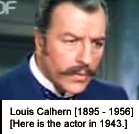 • • Hoping to advance her stage career, Julia Hoyt [15 September 1897 - 31 October 1955] hooked up with debonair leading man LOUIS CALHERN [1895 — 1956], whom she met when both were cast in a 1927 drama The Dark, which had a brief run at the Lyceum Theatre. Julia Hoyt and Louis Calhern were seen together often at Texas Guinan's during their short-lived marriage [1927 — 1932].
• • Hoping to advance her stage career, Julia Hoyt [15 September 1897 - 31 October 1955] hooked up with debonair leading man LOUIS CALHERN [1895 — 1956], whom she met when both were cast in a 1927 drama The Dark, which had a brief run at the Lyceum Theatre. Julia Hoyt and Louis Calhern were seen together often at Texas Guinan's during their short-lived marriage [1927 — 1932].

